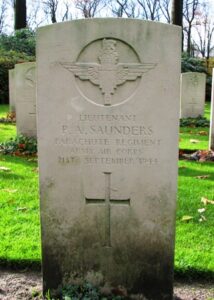Pembroke Dock County School was established in 1895, and its first pupils were taught in the Victoria Hotel. From 1899 the school moved to new premises at Argyle Street, and in 1947, the school became Pembroke Grammar School. Within the school is a finely carved wooden panel, which commemorates the 185 members of the School who served during the Great War. Amongst the names, the names of the nineteen men who died on active service are highlighted. There is a separate memorial for those who fell during WW2. These men are commemorated on this page.
The Great War, 1914-1918
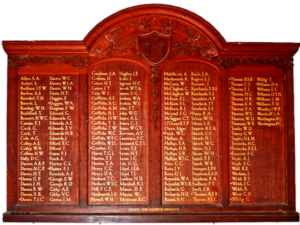
George Price Davies, Second Lieutenant, South Wales Borderers. George was the son of James and Louisa A. Davies, of 95, Gwyther Street, Pembroke Dock, and served with the 2nd Battalion, South Wales Borderers. The battalion had fought in Tientsin, China at the outbreak of war, then at Gallipoli, attached to 87 Brigade, 29th Division. The division then moved to France, and fought during the Battle of the Somme, and at Arras and Passchendaele the following year. They fought at the Battle of Cambrai in November and December, 1917 before moving back to Flanders early in 1918. The German Spring Offensive hit the British on the Somme on 21 March, 1918, and hit in Flanders just weeks later. The 29th Division fought at the desperate defensive battles of Estaires, Messines, Bailleul and Kemmel, before the war turned in favour of the Allies after a series of successes on the Somme in August. The Division then took part in the Offensive in Flanders, where they took part in the Action of Outtersteene Ridge, and then at the Battle of Ypres, and it was here that George was killed on 29 September 1918, aged 37. He is buried in Zantvoorde British Cemetery, Belgium.
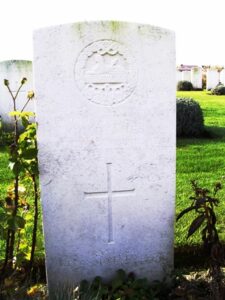
Thomas John Carlyle Davies, Second Lieutenant, Welsh Regiment. Thomas was the son of John Benjamin and Agnes Esther Davies, formerly of the London and Provincial Bank, of Main Street, Pembroke. Educated at Llandovery from 1911 to 1914, Thomas was the College Captain of rugby and a school cricketer. On leaving Llandovery, Thomas entered Clare College, Cambridge, but left prematurely on the declaration of War, to enlist, attending Officer Cadet Training at R.M.A. Sandhurst. Thomas was then commissioned into the Welsh Regiment, and in 1915 he was posted to the 1st Battalion, Welsh Regiment, which was in France attached to 84 Brigade, 28th Division. During September 1915, the battalion took part in preparatory attacks along the Hohenzollern Redoubt, prior to a General Offensive to be launched between Hulloch and Hill 70 on 1 October 1915, during the Battle of Loos. An attack by 1st Welsh was thwarted when it ran out of bombs and became cut off. Thomas was severely wounded in this action and died from his wounds on 2 October 1915, aged just 20. He has no known grave, and is commemorated on the Loos Memorial, France. The photograph of John is courtesy of Dr Frances Hurd.
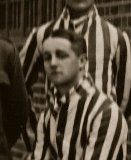
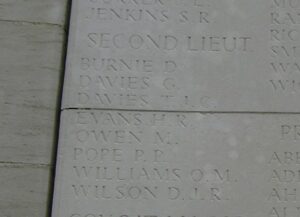
William Alexander Duggan, Sergeant, 7412, Wiltshire Regiment. William was the son of S.Q.M.S. J. Duggan (R.A.S.C.) and Agnes Duggan, of 99, Warley Road, Brentwood, Essex. He enlisted at Pembroke Dock into the 2nd Battalion, Wiltshire Regiment, which was attached to 21 Brigade, 7th Division, and moved to Zeebrugge on 7 August 1914. By then the City was falling to the Germans, and 7th Division moved to Ypres, where it took part in the first desperate Battle of Ypres, where the German advance on the Channel posts was halted. William was killed in the following Battle of Neuve Chapelle, on 14 March 1915, aged 28. He is buried in Estaires Communal Cemetery and Extension, France.
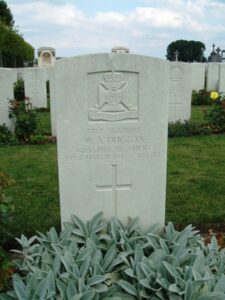
Ernest Victor Edwards, 2nd Lieutenant (Pilot), Royal Flying Corps. Ernest was born on 2 July 1889, the son of Ann and David Humphreys Edwards of Towyn House, Main Street, Pembroke. Educated at High School, Middlesbrough, and the County School, Pembroke Dock; on leaving he entered the Civil Service, and eventually became an employee of the Avon Rubber Company in London. Ernest joined the 3rd County of London Yeomanry (T.F.) on 24 April 1908. He served five years with the Colours, and joined the Reserve. He was called up on mobilization in August 1914, and served with the Mediterranean Expeditionary Force in Gallipoli, taking part in the landing at Suvla Bay in August 1915, and in much of the subsequent fighting. Ernest was wounded at Gallipoli, and invalided to Egypt. On recovery he rejoined his regiment, of which he was Sergeant, and proceeded with them to Salonika, and subsequently to Palestine, where he saw severe fighting. Ernest then transferred to the Royal Flying Corps, and was recommended for a commission, and gazetted 2nd Lieutenant on 10 February 1918. Sadly he was accidentally killed while flying Avro 504a, Serial A8541 at Ismailia on the 16 February 1918, and was buried there at Ismailia War Cemetery, Egypt. His Commanding Officer and Adjutant wrote: “I never saw anyone with more backbone; a true Britisher and much loved,” and a Cadet wrote: “To live with him was to come under the influence of an exceptional strength of character and a capacity for cheerfulness as amazing as ever present, combined with a wonderful personality.’
Frederick James Flutter, Sergeant, 5834, Cavalry. Frederick was born at St. Mary’s, Pembroke and enlisted at Pembroke into the Cavalry, joining the 3rd (Prince Of Wales Own) Dragoon Guards, attached to 6 Cavalry Brigade, 3rd Cavalry Division. The division was formed in September 1914 and moved to Antwerp. They fought at First and Second Ypres, and the Battle of Loos. In April 1917 the division fought during the Battle of the Scarpe, which is where Frederick was killed on 11 April 1917. He has no known grave, and is commemorated on the Arras Memorial, France.
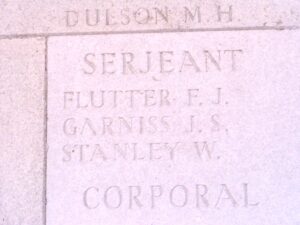
Elmore Wright George, Second Lieutenant, Welsh Regiment. Elmore was the son of Lieutenant William W. George, R.A.S.C. and Mary M. George, of Laburnum Villa, Pembroke. He had served in the Pembroke Yeomanry, but in 197 was commissioned into the 15th Battalion, Welsh Regiment, the ‘Carmarthen Pals’. The battalion had been formed in 1914 from a nucleus of Carmarthenshire men, and in December 1915 had moved to France as part of 114 Brigade, 38th (Welsh) Division. They had fought at Fleurbaix, and the famous battle of Mametz Wood, before moving to Ypres, where they successfully captured the Pilckem Ridge, and the village of Langemarck. In April 1918 the division was moved to the Somme area to help steady the line after the German Spring Offensive, and took up positions near Mesnil and Aveluy Wood. On 10 May 1918 the 15th Welsh launched a large scale raid on the German lines within Aveluy Wood. Disastrously the supporting artillery fire had been incorrectly ranged, and fell short, causing many casualties amongst the battalion. Elmore was killed by the artillery fire that day. He was 23 years old and is buried in Martinsart British Cemetery, France.
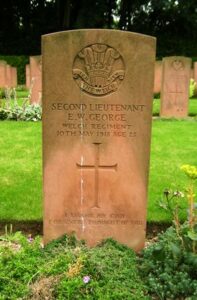
Osborne William Griffiths, Private, 13425, Coldstream Guards. Osborne was the son of George Llewhellin Griffiths and Edith A. Griffiths of Pembroke. He resided at Carew prior to the war, and enlisted at Hayward’s Heath into the Coldstream Guards. Osbourn was posted to the 3rd Battalion, Coldstream Guards, which was attached to 4th (Guards) Brigade, 2nd Division. The Division moved to France at the outbreak of war, and fought from the opening Battle of Mons, through the retreat south to the Aisne. The Guards were at the forefront of the fighting in France. On 20 August 1915 the 3rd Battalion transferred to 1st (Guards) Brigade, Guards Division, and took part in the Battle of Loos, which was launched on 25 September 1915. It was probably at Loos that Osbourne was wounded and returned home for treatment. Sadly he died of his wounds on 16 November 1915, aged 34, and is buried in Carew (St. Mary) Churchyard.
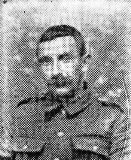
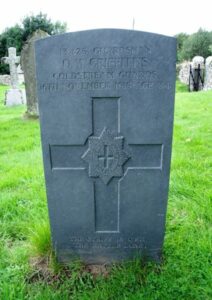
Gordon Valentine Gwyther, Driver, 105702, Royal Field Artillery. Gordon was the son of William Parsell Gwyther and Sarah Gwyther, of 79, Gwyther Street, Pembroke Dock. He served with the 268th Brigade, Royal Field Artillery, which served in Egypt and Palestine. Gordon was killed in Palestine, during the Third Battle of Gaza, on 4 November 1917, aged 33. He is buried in Beersheba War Cemetery, Israel.
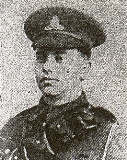
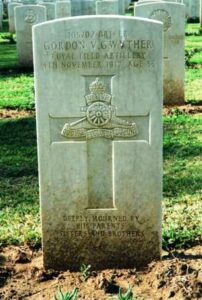
William George Paish, Lance Corporal, 1995, Cavalry. William was born at Trimulgherry, India, and resided at Pembroke prior to the war. He enlisted there into the 17th Lancers, Duke of Cambridge’s Own, which was attached to 7 Cavalry Brigade, 3rd Cavalry Division. The division had been in France since attempting to stem the German advance on Antwerp, and had fought at the Battles of Ypres, Loos and Arras. It took part in the opening of the Battle of Amiens, south of the River Somme, on 8 August 1918, which was the battle which turned the course of the war. William was killed that day, on 8 August 1918. He is buried in Manitoba Cemetery, Caix, France.
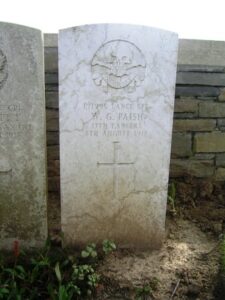
Reginald Archibald Sharp, Second Lieutenant, Royal Garrison Artillery. Reginald was the son of Captain Richard Sharp and Hannah Sharp, of Goodwick. He married Lilian Mary Jackson on 28 December 1912, and the couple lived at 7, Lynsted Lane, Teynham, Sittingbourne, Kent. He was commissioned into the Royal Garrison Artillery, and was posted to France to join their 47th Siege Battery, which was on the Somme. Reginald was killed on the Somme, during the assault on Delville Wood, on 2 September 1916 when his battery was in support of the assaulting troops. He was 28 years old, and is buried in Péronne Road Cemetery, Maricourt, France.
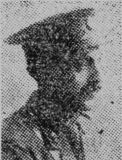
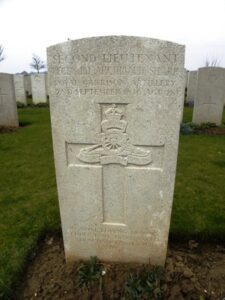
Arthur Evan Rideout Thomas, Corporal, 372, Australian Imperial Force. Arthur was born at Narberth, the son of Richard and Agnes Thomas, later of Newport House, South Cliff Gardens, Tenby. Prior to the war, he had served for three years with the Artists Rifles, and had then emigrated to Australia. Arthur enlisted on 22 February 1915 at Liverpool, NSW into the 18th Battalion, Australian Infantry, which were part of the 5th Brigade, 2nd Australian Division. The Battalion left Australia in May 1915 bound for Egypt, and after several months spent training there landed on ANZAC Cove, Gallipoli on 22 August 1915 to reinforce the badly depleted First Division who had been there since landing on 25 April. Just days later, the Battalion took part in the Battle for Hill 60, and Arthur was wounded there. He sadly Died of Wounds on 27 August 1915, aged 26. He was buried at sea, and so is remembered on the Lone Pine Memorial, Gallipoli.
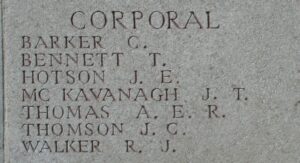
Benjamin Stewart Buckingham Thomas, MC, Lieutenant (Pilot), Royal Air Force. Benjamin was the son of Benjamin and Jessie Thomas, of 71, Gwyther Street, Pembroke Dock. He had originally served in France with the 9th Welsh, gaining the award of the Military Cross for gallantry on the Somme, before volunteering to serve with the Royal Flying Corps, where he trained as a Pilot. Benjamin was then posted to Number 11 Squadron, which flew the Bristol F2b. Benjamin was killed when his F2b, Serial D7978, with Lieutenant C. E. Spinks as Observer, was shot down over the Somme on 4 October 1918. He was 24 years old, and is buried in Grevillers British Cemetery, France.

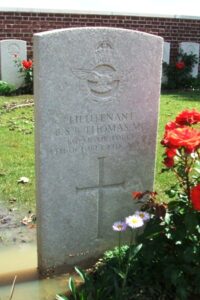
Frederick James Thomas, Private, G/40011, Middlesex Regiment. Frederick was the son of James and Annie Thomas, of 12, Grove Street, Pennar, Pembroke Dock. He enlisted at Highbeech, Essex into the Royal Fusiliers, but was later transferred into the 18th Battalion, Middlesex Regiment, which was attached to the 33rd Division, as Pioneers. The Division moved to France during November 1915, and saw its first major action during the Battles of the Somme, from July 1916 onwards. They then fought at the Battle of the Scarpe and at Bullecourt, before heading to Ypres, and fighting at the Menin Road and at Polygon Wood. They were still in Flanders when the German Spring Offensive hit, and fought at the Battle of Messines, and it was here that Frederick was killed on 13 April 1918. He was 25 years old, and is buried in Meteren Military Cemetery, France.

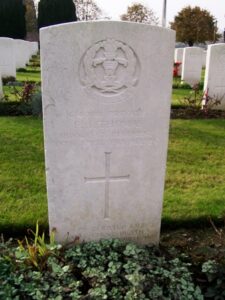
Richard Edward Lewis Treweeks, Lieutenant Commander, Royal Navy. Richard was born at St. Mary’s, Pembroke on 25 April 1893, the son of Major Richard and Mrs Gertrude Treweeks. He had served with the Mercantile Marine for several years prior to the war and had married Dorothy Martha Caistor in Manchester in December 1914, after having transferred to the Royal Navy on 1 April 1913. He was posted aboard the Warrior class armoured cruiser HMS Natal with the rank of Lieutenant. On 30 December 1915 Natal was lying in the Cromarty Firth with her squadron, under the command of Captain Eric Back RN. Shortly after 3.20pm, and without warning, a series of violent explosions tore through the ship. She capsized five minutes later. The most probable explanation was that a fire had broken out, possibly due to faulty cordite that ignited a magazine. Around 400 men were killed, some in the immediate explosions, others drowned as the ship capsized, or succumbed to the freezing water of the Cromarty Firth. Some bodies were recovered and given a proper burial, but Richard went down with the ship, and so he is commemorated on the Chatham Naval Memorial, Kent.
Frederick George Truscott, Private, 25713, Lancashire Fusiliers. Frederick was the son of Horatio George and Anne Prosser Truscott, of 70, Gwyther Street, Pembroke Dock. Frederick enlisted at Pembroke into the Royal Field Artillery, and was given the service number 137692. He was later transferred, probably due to earlier wounding or sickness, to the 12th Battalion, Lancashire Fusiliers, his number changing to 25713. The Battalion formed part of 65 Brigade, 22nd Division. The Division crossed to France in early September 1915, with all units being concentrated near Flesselles by 9 September. However it’s stay in France was to be very short, as on 27 October 1915 the Division, having been moved by train to Marseilles, began to embark for Salonika. It completed concentration there in November, although the final artillery units were still coming in as late as 13 December 1915. It remained in the theatre for the rest of the war, taking part in the Retreat from Serbia during December, 1915. From 10-18 August 1916 the Division fought at the battle of Horseshoe Hill, then from 13-14 September 1916 at the battle of Machukovo. From 24-25 April and 8-9 May 1917 the Division fought at the battle of Doiran. Frederick was killed in action near Doiran on 22 April 1918, aged 23. He is commemorated on the Doiran Memorial, Salonika.
Joseph Gilbert Webb, MC, Lieutenant, Royal Welsh Fusiliers. Joseph was the Husband of Elizabeth Webb, of Bulmer House, Haverfordwest. He had been commissioned into the Royal Welsh Fusiliers, and served with the 14th Battalion, Royal Welsh Fusiliers, which was attached to 113 Brigade, 38th (Welsh) Division. The Division landed in France during December 1915 and had spent their first winter in the trenches near Armentieres. In June they marched south to the Somme, where they were tasked with the capture of Mametz Wood. The attack on the wood began on 7 July, but met with fierce resistance, and it took until 14 July to totally clear the wood. The Division suffered terrible casualties at Mametz, and were taken out of the line, and moved to Ypres to rebuild. Here they fought at the Battle of Pilckem Ridge, and the Battle of Langemarck. They then moved to Armentieres, where they remained from September 1917 until March, 1918 when the German Spring Offensive was launched. The British had been over-run on the Somme, and so in April the Division was moved South, taking up positions North of Albert, from where they weathered the storm of the coming months. Joseph was wounded at some stage in early 1918, and evacuated to a Hospital in Britain for treatment, but sadly died of wounds on 9 May 1918. He is buried in St. Thomas A Beckett Churchyard, Haverfordwest. Joseph was awarded the Military Cross for the action in which he was wounded. The award was published in the London Gazette of 2 July 1918, and read; ‘For conspicuous gallantry and devotion to duty when in command of a fighting patrol of 8 men. Being attacked by an enemy patrol of 28 men, he at once opened fire and charged the enemy. He drove them back in confusion, inflicted heavy casualties on them, and captured two prisoners. All his patrol, including 3 wounded men, were brought back safely.’
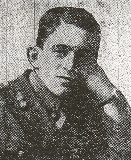
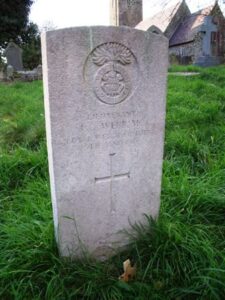
George Wildig, DCM, Lieutenant, Kings Shropshire Light Infantry. George was born at Cork, Ireland, the son of Major George Wildig, of the KSLI. He came to Pembroke Dock with his father in 1904, and was educated at the County School. After leaving school, George followed in his father’s footsteps, and enlisted into the 1st Battalion, King’s Shropshire Light Infantry, which was attached to 16 Brigade, 6th Division. On 10 September 1914 the Division landed at St Nazaire and proceeded to the Western Front, and arrived in time to reinforce the hard-pressed BEF on the Aisne, before the whole army was moved north into Flanders. Here they took part in the Action of Hooge during June, 1915, and in 1916 moved to the Somme, where the Division fought at the Battle of Flers-Courcelette, the Battle of Morval and the Battle of Le Transloy. George was awarded the Distinguished Conduct Medal while serving with them in France, his award being listed in the London Gazette of 11 January 1916. He was then commissioned, and married Elsie Mary Vaughan whilst on leave in the summer of 1916. George served for the rest of the war as a Lieutenant with the 161st Training Battalion. He died in hospital at Birmingham on 6 November 1918, aged 26. George was buried in Pembroke Dock (Llanion) Cemetery on Armistice Day.
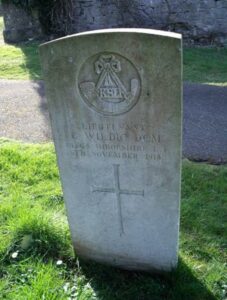
David Aubrey Williams, Second Lieutenant, South Wales Borderers. David was the son of William and Marianne Williams, of 95, Laws Street, Pembroke Dock. He was commissioned from the Royal Engineers into the 1st Battalion, South Wales Borderers, and landed in France on 5 January 1916. The 1st SWB was attached to 3 Brigade, 1st Division, and had been in France since the outbreak of war. In 1916 the Division moved to the Somme, where it took part in the Battle of Albert during the opening of the Somme Offensive. David was killed three weeks into the battle, on 25 July 1916. He is commemorated on the Thiepval Memorial, France. His brother, Thomas Howard Williams, also fell.
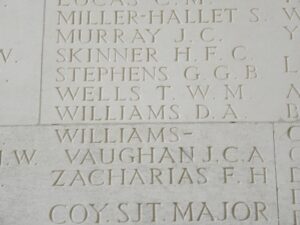
Samuel Mervyn Williams, Second Lieutenant, Notts & Derby (Sherwood Foresters). Samuel was the son of Dr. Richard Henry Williams and of Edith Sophia Williams, of Penfro, St. Bride’s Hill, Saundersfoot. Samuel was born in Pembroke Dock, and was educated at Llandovery, Plymouth and St. George’s College, Kingsway. He passed into Sandhurst on 18 January 1915 and was commissioned into the Sherwood Foresters on 15 August. Samuel was then posted to their 2nd Battalion, which was attached to 71 Brigade, 6th Division, arriving on the Western Front on 4 October 1916. The Battalion had been in France since landing at St. Nazaire on 11 September, 1914. They had rushed to reinforce the BEF on the Aisne, and had then been transferred to Hooge. In 1916 the Division moved south, to take part in the Somme Offensive, and fought at Flers-Courcelette, Morval and Le Transloy. Samuel had only gone into action for the first time on 13 October, but was killed in Action just three days later, on 16 October 1916 during the Battle of Le Transloy. He was aged just 19, and is remembered on the Thiepval Memorial, France.
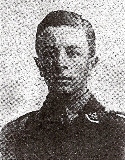
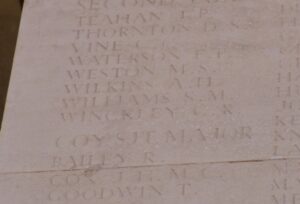
Thomas Howard Williams, Private, 765298, London Regiment. Thomas was the son of William and Marianne Williams, of 95, Laws Street, Pembroke Dock. He had worked for 19 years in the service of the London and Provincial Bank, and married Nancy Lowrie, of Tanglewood, Lisvane, Cardiff, just after having enlisted at Cardiff into the 1/28th Battalion, London Regiment (Artists Rifles). The battalion was an officer training battalion for most of the war, and on 28 June 1917 joined 190 Brigade, 63rd (Royal Naval) Division. The RND was at Arras by then, before moving to positions at Ypres, where they took part in the Battle of Passchendaele. Thomas was killed at Passchendaele on 30 October 1917, aged 34, and is commemorated on the Tyne Cot Memorial, Belgium. His brother, David Aubrey Williams, also fell.
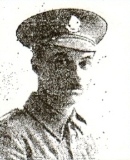
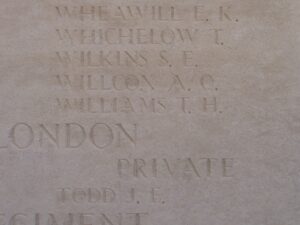
World War Two, 1939-1945
John Henry Bevans, Sergeant (Pilot), Royal Air Force Volunteer Reserve. John was born on 13 December 1917, the son of Shipwright Inspector John Bevans, and of Emilie Jane Bevans (nee Williams), of 7, Waterloo Terrace, Pembroke Dock. He was educated at Pembroke Dock Grammar School. John enlisted into the Royal Air Force Volunteer Reserve soon after the outbreak of war and after training as a Navigator, was posted to 106 Squadron, Royal Air Force. At the outbreak of the Second World War the squadron was flying Hampdens with No. 5 Group, and until early 1941 had a training role. It then reverted to front-line status and began regular night bombing operations against occupied Europe from its base at RAF Coningsby, in Lincolnshire. On 29 June 1941 John took off from Coningsby aboard Handley Page Hampden I, Serial AD895, which joined a large force of bombers sent to destroy strategic targets in Bremen. John was killed when the Hampden was intercepted and shot down by a German night fighter just South of Uetersen, near Hamburg during the early hours of 30 June 1941. The 24-year-old is buried alongside his crew in Sage War Cemetery, Germany. His parents later moved to Acton, Middlesex.
Ernest Roy Darlington, Private, 6149590, The East Yorkshire Regiment. Ernest, known as Roy, was born on 17 April 1920, one of six sons of Thomas Arthur James Darlington and Lily Darlington (nee Jubb), of Pembroke Dock and was educated at Pembroke Dock Grammar School. Roy married Annie Stella Palmer at St. Nicholas Church, Bradford on 5 February 1944, while stationed nearby with the 2nd Battalion, East Yorkshire Regiment. The battalion landed on Normandy on D-Day, 6 June 1945, attached to the 3rd Division, and played a large part in the break out from Normandy. Ernest was killed in Normandy on 11 August 1944. He was 24 years old, and is buried at St. Charles de Percy War Cemetery, France.
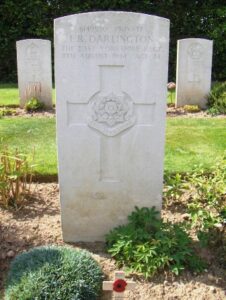
Colin Lewis Davies, Sergeant, 1187719, Royal Air Force Volunteer Reserve. Colin was educated at Pembroke Dock Grammar School. He enlisted into the Royal Air Force Volunteer Reserve soon after the outbreak of war and after training as a pilot was posted to 227 Squadron, Royal Air Force, which was based at RAF Ta Kali, Malta. On 6 January 1943, Colin was flying Bristol Beaufighter If, Serial V8279 when he spotted a German Dornier Do24 flying boat. His Beaufighter was hit as he attacked the aircraft and he crashed into the Mediterranean, killing himself and his co-pilot, Patrick Goalby. Colin has no known grave and is commemorated on the Malta Memorial, Malta.
William George Evans, Bombardier, 1108551, Royal Artillery. William was the son of John Maurice and Ruth Evans of Pembroke, and was educated at Pembroke Dock Grammar School. He married Selina Evans, of North Harrow, Middlesex. William served as a Bombardier with 455 Independent Light Battery, Royal Artillery. The Battery served in Burma during the war, and fought in terrible conditions. William became ill during July 1944, and was hospitalised in India. He died of malaria on 15 August 1944, aged 32, and is buried in Gauhati War Cemetery, India.
Trevor John Hordley, Flying Officer (Pilot), Royal Air Force Volunteer Reserve. Trevor was the son of Frederick Hubert Hordley and Sarah Anne Hordley (nee Gibby), of Pembroke Dock. He was educated at Pembroke Dock County School and married Muriel M Hillyard in 1944. He served with 207 Squadron, RAF, which was a heavy bomber squadron, equipped with the Avro Lancaster. On 7 July 1944, Lancaster ND567, EM-V, took off from RAF Spilsby, piloted by Trevor, bound for targets at St.Leu d’Esserent. On the morning of 8 July 1944 the Lancaster was shot down, and crashed on the edge of woods near Sérifontaine. Trevor and four other members of his crew were killed in the crash. All five men are buried in the National Cemetery, Marissel, Beauvais, France.
Charles Frederick Jelley, DFC, Flying Officer (Observer), 161812, Royal Air Force Volunteer Reserve. Charles was the son of Christopher James Jelley and Dorothy Ellis Jelley, of Pembroke. He was educated at Pembroke Dock County School, before joining the Royal Air Force, where he became an Observer with 635 Squadron, RAF, which was an elite Pathfinder unit. Charles was awarded the Distinguished Flying Cross in the London Gazette of 15 November 1943. On 6 January 1945, Charles was serving as a mid-upper turret gunner aboard Lancaster PB-228, during a raid on Hanau, when it collided with another Lancaster above Grobaheim, Germany, and crashed with the loss of seven men. Charles was 21 years old, and is buried in Durnbach War Cemetery, Germany.
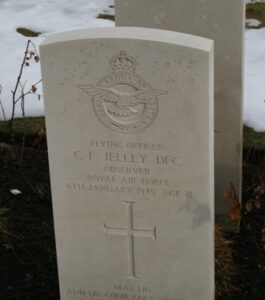
Aubrey Thomas Grenville Jones, Sergeant (Flight Engineer), 571686, Royal Air Force. Aubrey was born at Neyland in 1921, the son of Margaret Jones (nee Reynolds). He was educated at Pembroke Dock County School, prior to joining the Royal Air Force in 1937. Aubrey became a Flight Engineer with 460 RAAF Squadron, which flew the Avro Lancaster. On 28 April 1944, he was a member of the crew of Lancaster LL-906, which was on a mission from RAF Binbrook for Friedrichshafen, when it was intercepted and shot down by a German Night Fighter. Aubrey was among seven men killed aboard the Lancaster when it crashed in France. He was 23 years old, and is buried in a collective grave at Appenwihr Churchyard, France, alongside his fellow crew members.
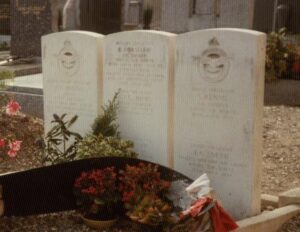
Ernest George Lewis, Sergeant (Air Bomber), 1585091, Royal Air Force Volunteer Reserve. Ernest was the son of William Ewart Lewis and Sadie Gwendoline Lewis (nee Silcox), of Pembroke Dock. He was sent to South Africa to Air Training School from November 1942 until July 1943 when he became a Sergeant and came home to join 626 Squadron, which was a heavy bomber squadron based at RAF Wickenby, equipped with the Avro Lancaster. On the morning of 23 June 1944, Ernest was aboard Lancaster Serial LM102, UM-Z2, which was part of a force tasked with bombing Rheims, when the Lancaster crashed in farm land near the village of Belloy, killing all the crew. Ernest was 21 years old, and is buried in Belloy Churchyard, Oise, France, alongside his fellow crew members.
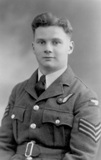
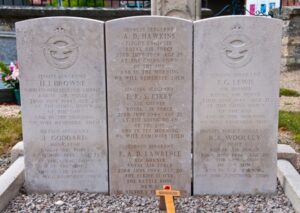
Patrick Gerald McGrath, Sergeant (Air Gunner), 1081837, Royal Air Force Volunteer Reserve. Patrick was educated at Pembroke Dock County School. He served as an Air Gunner with 214 Squadron, Royal Air Force, which was a bomber squadron, equipped with the Short Stirling. On 30 May 1942 Patrick was aboard Stirling W7534, which took off from RAF Stradishall as part of a 1,000 bomber force, destination Cologne. On the return leg of the journey, on the morning of 31 May 1942, it seems that Patrick’s Stirling collided with a Wellington near Monchengladbach, and both bombers blew up, killing all aboard. Patrick was 34 years old and is buried alongside his fellow crewmen at Reichswald Forest War Cemetery, Germany.
Norman Henry Owen, Leading Aircraftman (Pilot U/T), 1101265, Royal Air Force Volunteer Reserve. Norman was born at Corwen in 1921, the son of Gwilym Ernest Owen and Gwendoline Owen. His father worked for the Ministry of Supply and moved to Pembroke Dock prior to the war. Norman was educated at Pembroke Dock County School, before enlisting into the Royal Air Force Volunteer Reserve and was posted to No 1 Elementary Flying Training School at RAF Hatfield, in Hertfordshire for pilot training. On 10 December 1940 Norman was flying a Tiger Moth from Hatfield when he collided with a Miles Magister, Serial L8070 over St Albans, Hertfordshire during a training flight and crashed to the ground, killing himself. The remains of the 26-year-old were buried in Rhyl Church Cemetery, Wales.
George Richard Phelps, Flight Lieutenant (Pilot), 150236, Royal Air Force Volunteer Reserve. George was born on 2 May 1922, the son of Joseph George Phelps and Phebe Jane Phelps (nee Phillips), of Dairy Hayes, Milton. He was educated at Pembroke Dock County School. George enlisted into the Royal Air Force Volunteer Reserve and trained as a pilot before being posted to 166 Squadron, Royal Air Force. The squadron was a heavy bomber squadron, based at RAF Kirmington. On the night of 1 March 1945 George took off from Kirmington, flying Avro Lancaster I, Serial ME447 on what proved to be the final raid of the war on the German town of Mannheim. George was killed when his Lancaster was shot down and crashed that night. The 22-year-old is buried in Durnbach War Cemetery, Germany.
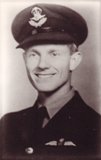
Arthur Eveleigh Mervyn Prickett, Flight Sergeant (Observer), 366382, Royal Air Force. Arthur was born on 4 November 1909, the son of William Charles Prickett and Maud Prickett of 23, Gwyther Street, Pembroke Dock, and was educated at Pembroke Dock School. He married Dorothy Helen Pike, of 27, Front Street, Pembroke Dock at West Molesey, Surrey, in 1938. Arthur had enlisted into the Royal Air Force at sometime prior to the war and was posted to No 4 Service Flight Training School, at RAF Habbaniya. Habbaniya was a peace-time Royal Air Force station, maintained under the Anglo-Iraqi treaty of 1930 which permitted a British base west of the Euphrates, and the permanent Headquarters of the R.A.F. in Iraq. Arthur was killed when the airfield was attacked by German HE111’s on 6 May 1941, aged 31. He is buried in Habbaniya War Cemetery, Iraq.
Sidney George Prickett, Chief Engine Room Artificer, C/MX 47331, Royal Navy. Sidney was born on 16 March 1913, the son of John Henry Prickett and Emily Harriet Prickett (nee Wells), of Church House, Albion Square, Pembroke Dock. He enlisted into the Royal Navy on 30 July 1928 and was posted to HMS Fisgard for training. Sidney had married soon afterwards, to Catherine Prickett, of Dunfermline. Following the outbreak of war, Sidney was serving aboard the Town-Class light cruiser, HMS Liverpool. During the Second World War, Liverpool operated variously with the naval stations in the East Indies and China and with the Mediterranean and Home fleets. She instigated a diplomatic incident with Japan in January 1940 when she intercepted and boarded the liner Asama Maru off the coast of Japan. Liverpool later fought in the battles of the Espero Convoy and Calabria, the Arctic Convoys, and Operation Harpoon during the Malta Convoys. Seriously damaged in two attacks by torpedo bombers, Liverpool gained four battle honours for her service. Sidney was killed aboard Liverpool during an aerial attack on 14 June 1942, during Operation Harpoon. He was 29 years old, and is commemorated on Panel 60 of the Chatham Naval Memorial, Kent.
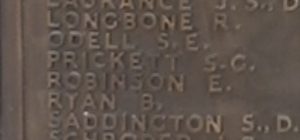
William John Cephas Rouse, Lieutenant, Royal Naval Volunteer Reserve. William was born on 28 July 1911, the son of William Rouse and Katherine Rouse (nee Jenkin), of Pembroke Dock. He was educated at Pembroke Dock County School, before entering University at London, where he graduated BSc and became a school teacher at Hereford. William married Mary Owens, of Hakin, Milford Haven in 1940. William served in the Royal Navy at HMS Spurwing, the Royal Naval Air Station at Sierra Leone. William died after an accidental fall at Sierra Leone on 15 February 1944, after fracturing his skull. The 33-year-old is buried in Freetown (King Tom) Cemetery, Sierra Leone.
Peter Argent Saunders, Lieutenant, 217639, Army Air Corps. Peter was the son of Dr Edward Argent Saunders and Louisa Gertrude Saunders, of Ford. He was educated at Pembroke Dock County School. Peter was commissioned into the Rifle Brigade on 15 November 1941, and on 3 January 1943 volunteered to serve with the Army Air Corps, joining D Company, 10th Battalion, Parachute Regiment. He saw his first action during the Italian Campaign in 1943, when he was Mentioned in Despatches for his bravery. He returned to Britain prior to the invasion of Normandy, and took part in Operation Market Garden in September 1944, landing with his battalion at Arnhem on 17 September 1944, in command of D Company. Peter was killed in action during a heavy German attack at Oosterbeek on 22 September 1944, aged 24, and is buried in Arnhem Oosterbeek War Cemetery, Netherlands.
